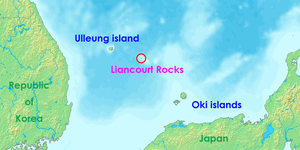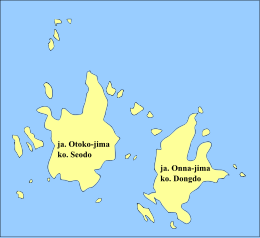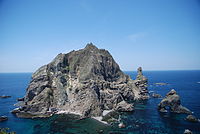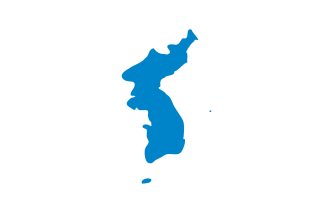
The Korean Unification Flag, also known as the Flag of the Korean Peninsula, is used to represent all of Korea when North Korea and South Korea participate as one team at international sporting events. It was introduced at the 1990 Asian Games but not used by a unified team until the 1991 World Table Tennis Championships. It is a white field charged with a sky blue silhouette of the Korean Peninsula, Jeju Island, and Ulleungdo. The flag's depiction of Korean territorial claims has earned it the chagrin of Japan, which claims the Liancourt Rocks. The disputed islets were added to the flag in 2003 but removed in 2018 upon the request of the International Olympic Committee (IOC). Outside of sports, the flag has been used to express support for Korean reunification in general, particularly in North Korea.

The Oki Islands is an archipelago in the Sea of Japan, the islands of which are administratively part of Oki District, Shimane Prefecture, Japan. The islands have a total area of 346.1 square kilometres (133.6 sq mi). Only four of the around 180 islands are permanently inhabited. Much of the archipelago is within the borders of Daisen-Oki National Park. Due to their geological heritage, the Oki Islands were designated a UNESCO Global Geopark in September 2013.
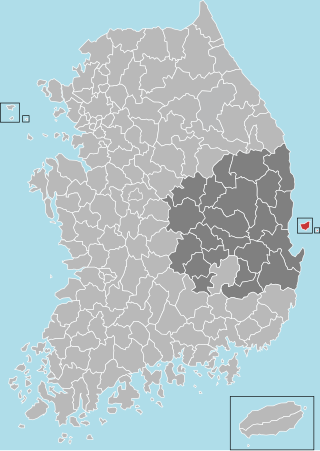
Ulleung County is a county in North Gyeongsang Province, South Korea.

Ulleungdo, also spelled Ulreungdo, is a South Korean island 120 kilometres east of the Korean Peninsula in the Sea of Japan, formerly known as Dagelet Island or Argonaut Island in Europe. Volcanic in origin, the rocky steep-sided island is the top of a large stratovolcano which rises from the seafloor, reaching a maximum elevation of 984 metres (3,228 ft) at Seonginbong Peak. The island is 9.5 kilometres (6 mi) in length and ten kilometres (6 mi) in width; it has an area of 72.86 km2 (28.13 sq mi). It has a population of 10,426 inhabitants.
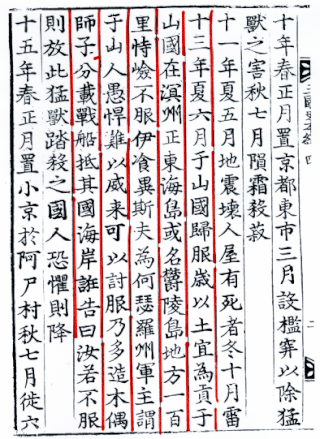
Usan-guk, or the State of Usan, occupied Ulleung-do and the adjacent islands during the Korean Three Kingdoms period. According to the Samguk Sagi, it was conquered by the Silla general Kim Isabu in 512. He is said to have used wooden lions or tigers to intimidate the residents into surrendering. It has been written that the alias of Usan-guk is Ulleung-do. Usan-guk rarely entered into historical records, but appears to have continued a largely autonomous existence until its loss of independence to Goryeo in 930.

The Syngman Rhee Line was a marine boundary line established by South Korean President Syngman Rhee in his "Peace Line" declaration of January 18, 1952, establishing a wide area of maritime sovereignty, beyond internationally accepted territorial waters, around the entire Korean Peninsula. This included placing the Liancourt Rocks (Dokdo/Takeshima) in South Korean territory. The line was abolished in 1965 with the signing of a Japanese–South Korean fishing agreement.

The Tsushima Basin or Ulleung Basin is an oceanic basin located where the Sea of Japan meets the Korea Strait. It lies immediately south of Ulleung-do and Liancourt Rocks, in the eastern end of the South Korean EEZ and the western end of the Japanese EEZ.

The Rusk documents are the official diplomatic correspondence sent by Dean Rusk, the United States Assistant Secretary of State for Far Eastern Affairs, to Yang You-chan, the South Korean ambassador to the U.S. on August 10, 1951.

Jukdo is a small island in Jeodong-ri, Ulleung-myeon, Ulleung County, North Gyeongsang Province, South Korea. It is next to the island Ulleungdo in the Sea of Japan. It is also known as Jukseodo. It lies 2 km (1 mi) east of Ulleungdo, and is the largest island in the group apart from Ulleungdo itself. In 2004, one family of three members was living on the island.
Takeshima (竹島) is the Japanese name for the Liancourt Rocks.
Usan-do is a historical name for an island in the Sea of Japan described in Korean records. It was part of the ancient state of Usan-guk, but its exact identity is disputed. It may refer to:
Dokdo (독도) is the Korean name for the Liancourt Rocks.

An Yong-bok was a Korean fisherman in 17th century of Joseon Dynasty famous for his travels to Japan. His activities were instrumental in determining fishery rights in the waters of Ulleungdo and the Liancourt Rocks, two islands in the East Sea.

The Liancourt Rocks dispute, also called the Takeshima dispute or Dokdo dispute is a territorial dispute between South Korea and Japan regarding sovereignty over the Liancourt Rocks, a group of small islets in the Sea of Japan. The rocks also go by the names Dokdo and Takeshima. North Korea also claims sovereignty of the islands, but has not pursued its claim to the same extent as the other parties.

ROKS Dokdo (LPH-6111) is the lead ship of the Dokdo-class amphibious assault ship of the Republic of Korea Navy, launched on 12 July 2005 at the shipyard of Hanjin Heavy Industries & Constructions Co. in Busan. ROKS Dokdo was the flagship of the Fifth Component Flotilla of the Korean Navy until the launch of ROKS Marado in 2018. Previously, this title was held by the 9,000-ton at-sea Underway Replenishment (UNREP) support vessel ROKS Cheonji.
Dokdo Museum is the name used for two museums in Korea that relate to the Liancourt Rocks, known as Dokdo in Korean. One of the museums is located in Ulleungdo and the other, which opened later, is in Seoul.

Daehanjiji is an elementary school geography text about the Korean Empire by Hyeon Chae. Hyeon Chae wrote the book in 1899, translating and compiling Japanese and Korean sources. It was published by Gwangmun-sa, Seoul.

Japan is currently engaged in several territorial disputes with nearby countries, including Russia, South Korea, North Korea, the People's Republic of China, and the Republic of China (Taiwan).
The Dokdo Volunteer Garrison (Korean: 독도의용수비대) was a South Korean paramilitary outpost on the Liancourt Rocks. Both South Korea and Japan each claim sovereignty over the islands. The garrison was established by volunteers from Ulleungdo Island and the Korean Veterans Association, and was led by Hong Sun-chil. The garrison was a private organization that is considered to have laid the foundation for South Korea to exercise practical territorial sovereignty over the islands. According to multiple sources, including the Encyclopedia of Korean Culture, the garrison engaged in several clashes against the Japan Coast Guard, and was maintained from 1953 to 1956 until South Korean police forces fully took over operations over the island.
In Japan, Takeshima Day (竹島の日) is celebrated on February 22 every year since 2005. Public events related to Takeshima are held on this day, and the day is also used to demonstrate Japan's sovereignty over the Liancourt Rocks.
